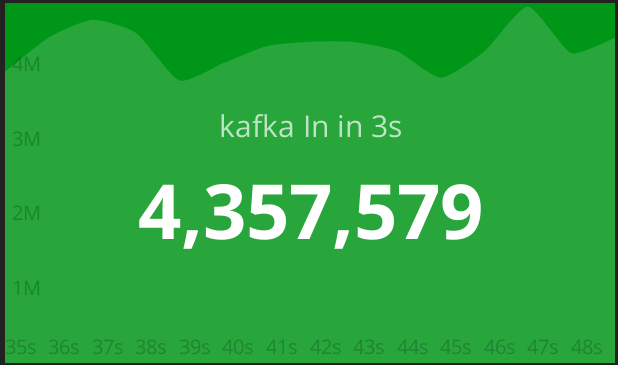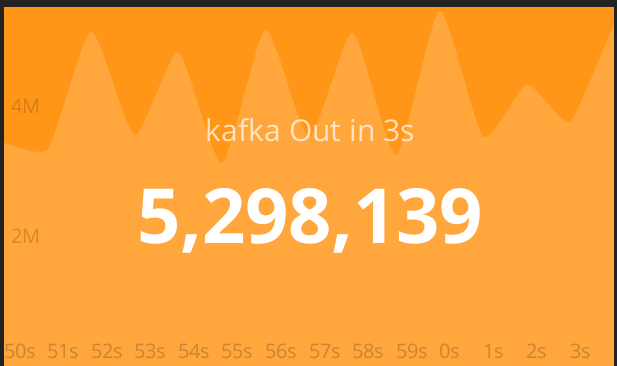使用dashing写一个kafka监控dashboard
problem
kafka是一个以高吞吐著称的分布式消息队列组建,由linkedin于2010年12月开源,目前已经apache的正是项目, 2013年12月发布0.8稳定版, 官方一直没有提供比较好的状态监控解决方案,仅提供了一些JMX的MBean接口,本文将基于这些JMX的接口构建一个基本的kafka核心状态监控dashboard。
目前我们还没有从0.72迁移到最新版本,所以本文仍以kafka 0.72为例。
tools
- dashing dashing是shopify开源的一个简单、易用又不失强大的dashboard框架,几本的使用步骤如下:
sudo gem install dashing# 安装dashing new kafka_dashboard# 创建示例项目- 定制dashboards布局 # dashboards目录,参考sample.erb和sampletv.erb文件
- 编写数据jobs # jobs目录,参考示例项目*.rb
cd kafka_dashboard && dashing start# 启动
- jmxcmd jmxcmd是一个简单的jmx命令行客户端工具,当然如果你用的是jruby的话,可以直接使用jmx gem, 目前原生的ruby还没有可以直接访问jmx的方法,所以此处引入了这个叫jmxcmd的外部jar包。
how
- 首先定义定义要监控的数据项
<% content_for :title do %>aqueducts dashboard<% end %>
<div class="gridster">
<ul>
<li data-row="1" data-col="1" data-sizex="2" data-sizey="1">
<div data-id="bytesIn" data-view="Graph" data-title="kafka In in 3s" style="background-color:#009618"></div>
</li>
<li data-row="1" data-col="1" data-sizex="2" data-sizey="1">
<div data-id="bytesOut" data-view="Graph" data-title="kafka Out in 3s" style="background-color:#ff9618"></div>
</li>
</ul>
</div>
- 编写jobs从kafka获取监控数据
@numOfPoints = 15
@kafkaHost = "my.kafka.host"
@kafkaPort = "9999"
@jmxcmdPath = "/home/castomer/bin/jmxcmd.jar"
@jmxBean = "kafka:type=kafka.BrokerAllTopicStat"
def getKafkaStatus(bean, key)
value = `java -jar #{@jmxcmdPath} - #{@kafkaHost}:#{@kafkaPort} #{bean} #{key} 2>&1`
# jmxcmd 默认把输出打印到stderr,因此需要将stderr重定向到stdout
return value.split(": ").last.to_i;
end
bytesIn = []
bytesOut = []
pointsIn = []
pointsOut = []
bytesIn << getKafkaStatus(@jmxBean, "BytesIn")
bytesOut << getKafkaStatus(@jmxBean, "BytesOut")
(1..@numOfPoints).each do |i|
bytesIn << getKafkaStatus(@jmxBean, "BytesIn")
bytesOut << getKafkaStatus(@jmxBean, "BytesOut")
pointsIn << { x: i, y: bytesIn[i] - bytesIn[i - 1] }
pointsOut << { x: i, y: bytesOut[i] - bytesOut[i - 1] }
end
last_x = pointsIn.last[:x]
SCHEDULER.every '3s' do
bytesIn.shift
bytesOut.shift
pointsIn.shift
pointsOut.shift
last_x += 1
bytesIn << getKafkaStatus(@jmxBean, "BytesIn")
bytesOut << getKafkaStatus(@jmxBean, "BytesOut")
pointsIn << {x: last_x, y: bytesIn[@numOfPoints] - bytesIn[@numOfPoints - 1] }
pointsOut << {x: last_x, y: bytesOut[@numOfPoints] - bytesOut[@numOfPoints - 1] }
send_event('bytesIn', points: pointsIn)
send_event('bytesOut', points: pointsOut)
end
result


todo
以上实现kafka throughout的dashboard监控,还有一些其他的监控指标在需要的时候再增加咯,下班回家~